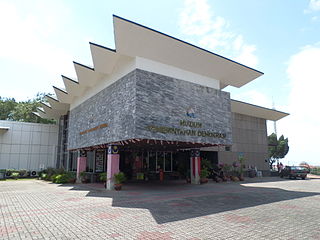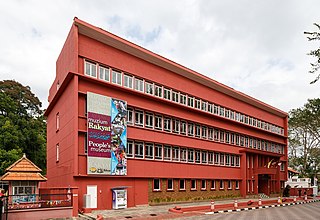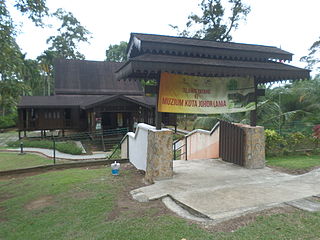
Malaysia is a modern concept, created in the second half of the 20th century. However, contemporary Malaysia regards the entire history of Malaya and Borneo, spanning thousands of years back to prehistoric times, as its own history.

Negeri Sembilan, historically spelled as Negri Sembilan, is a state in Malaysia which lies on the western coast of Peninsular Malaysia. It borders Selangor on the north, Pahang in the east, and Malacca and Johor to the south.

Malacca City is the capital city of the Malaysian state of Malacca, in Melaka Tengah District. It is the oldest Malaysian city on the Straits of Malacca, having become a successful entrepôt in the era of the Malacca Sultanate. The present-day city was founded by Parameswara, a Sumatran prince who escaped to the Malay Peninsula when Srivijaya fell to the Majapahit. Following the establishment of the Malacca Sultanate, the city drew the attention of traders from the Middle East, South Asia, and East Asia, as well as the Portuguese, who intended to dominate the trade route in Asia. After Malacca was conquered by Portugal, the city became an area of conflict when the sultanates of Aceh and Johor attempted to take control from the Portuguese.

The National Museum is a public museum in Kuala Lumpur, Malaysia dedicated to Malaysian art, culture, and history. Located on Jalan Damansara close to Perdana Lake Gardens across KL Sentral station. Its façade comprises elements from both traditional Malay and modern features. It was inaugurated on 31 August 1963, and it serves as a repository of Malaysia's cultural and historical heritage.

Ayer Keroh is a town situated in Melaka Tengah District, Malacca, Malaysia. It is the seat of the state government since 2006, being the home of the state secretariat building complex – Seri Negeri complex and one of a few towns which formed the Hang Tuah Jaya municipality.

Melaka Tengah District is one of the three administrative districts in Malacca, Malaysia. It borders Alor Gajah District to the north and Jasin District to the east. The capital of the state, Malacca City, is located in this district. This district is the major destination of tourists in Malacca as most historical spots are situated within it.

Tamil Malaysians, also known as Malaysian Tamilar, are people of full or partial Tamil descent who were born in or immigrated to Malaysia from Tamil Nadu, India and the Tamil regions of north-east Sri Lanka. The majority of 1.8–2 million people 80% of the Malaysian Indian populations in Malaysia were from Indian Tamil ethnic groups from Tamil Nadu and Sri Lanka. The bulk of Tamil Malaysian migration began during the British Raj, when Britain facilitated the migration of Indian workers to work in plantations. There are, however, some established Tamil communities from before British colonialism.

Malacca, officially the Historic State of Malacca, is a state in Malaysia located in the southern region of the Malay Peninsula, facing the Strait of Malacca. The state is bordered by Negeri Sembilan to the north and west and Johor to the south. The exclave of Tanjung Tuan also borders Negeri Sembilan to the north. Its capital is Malacca City, which has been listed as a UNESCO World Heritage Site since 7 July 2008.

Malacca Art Gallery is an art gallery in Malacca City, Malacca, Malaysia which was established in 1958. It is located on the upper floor of the building, which houses the Malaysia Youth Museum at the ground floor and was originally established as the administrative office of Dutch Malacca government.

The Chitty Museum is a museum about the minority Chitty community, which is located within the Chitty Village area in Malacca City, Malacca, Malaysia. It is housed in a traditional Chitty house which has been renovated by PERZIM.

The Democratic Government Museum is a museum about the development and practice of parliamentary democracy, which is located at St. Paul's Hill in Malacca City, Malacca, Malaysia. The museum was formerly the Malacca State Legislative Assembly building, which had moved to Ayer Keroh as its present location since February 2000, in which its foundation stone was laid on 13 August 1961.

People's Museum is a museum in Malacca City, Malacca, Malaysia, which records and preserves the achievements of Malacca in the development sector and officially opened on 15 April 1992 by then Prime Minister Mahathir Mohamad. It is located at the ground floor of the former Historical City of Malacca Municipal Council building, originally constructed in the 1960s and believed to be built on top of the ruins of Dutch building, which also houses the Beauty Museum and Kite Museum at the upper floors.

Malacca Islamic Museum is a museum about Islamic culture in Malacca City, Malacca, Malaysia. It exhibits various artifacts about the replica of early Quran manuscripts, history of mosques in the state, various religious figures from the state and Malaysia etc. The museum building used to house the Islamic Council of Malacca Office before it was shifted to its current location beside the State Mosque. Before the establishment of the Islamic museum, extensive renovations were done to create space for the museum.

Malacca Literature Museum is a museum about Malaysian literary works in Malacca City, Malacca, Malaysia, which resembles the structural design of a residence and was officiated by Chief Minister Mohd Zin Abdul Ghani in 1984.

St. Paul's Hill is a hill in Malacca City, Malacca, Malaysia. It was originally known as Malacca Hill during the Sultanate period and Mary's Hill during the Portuguese period.

The Malay and Islamic World Museum is a museum about Malay and Islamic cultures in Malacca City, Malacca, Malaysia. It is housed in the Bastion House building which was built in 1910 and occupied by the British rubber company Dunlop until 1986. The building has the English architectural elements, the rectangular shape design with deep slanted roofs. The museum displays the information about the spread of Islam in the world, important and historical Malay and Muslim figures, important Islamic buildings, artifacts, traditional dress etc.

Royal Malaysian Navy Museum is a museum which exhibits items used by the Royal Malaysian Navy in Malacca City, Malacca, Malaysia. Exhibits included photos of admirals, medals of honor, as well as information about the various ranks in the naval command, evolution of naval uniforms, naval weapons, communication equipment, navigation symbols and training programs.

Malacca Al-Quran Museum is a museum about Quran in Malacca City, Malacca, Malaysia, which was developed with the cooperation between Restu Foundation and Malacca State Government and opened to the public on 10 January 2008. It is located next to the state mosque of Malacca and consists of 12 main halls and a shop.

The Kota Johor Lama Museum is a museum in Johor Lama, Kota Tinggi District, Johor, Malaysia. The museum is about the history of Johor Lama.





















